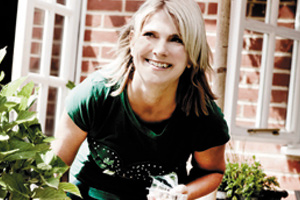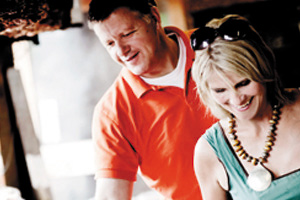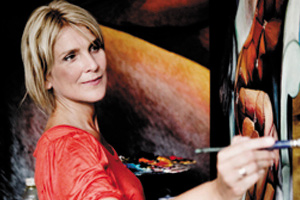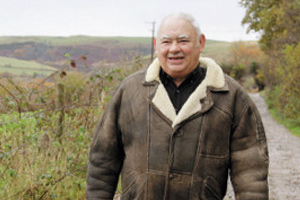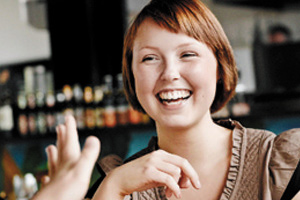Testimonials
Heidi
Ileostomy since 2002
Country: United Kingdom
Occupation: Artist and Painter
Leisure time: Travelling and family
I was diagnosed with Crohn’s disease when I was 16 years old, after a terrible year of exhaustion, pain, vomiting, and diarrhoea and weight loss. I was extremely weak and weighed under 6 stone. I couldn’t eat and would even wretch at the smell of food. It felt as if someone was continuously twisting a knife in my abdomen. I could barely walk, had to crawl up the stairs on all fours, and when touched even lightly, it felt as if I were being punched.
I had moved to a new house, started a new school, and found it difficult to fit in. At first my GP put my symptoms down to the stress of the move and offered me a tonic to pick me up. Later he suggested that I was anorexic, and despite my own and my anxious parents’ protests, offered no help or advice.
I was too weak to sit my GCE exams at school and focused on trying to build up my strength in order to take the exams at college the following year. However, within a week of starting college that September, I was admitted to hospital for an emergency operation to remove one third of my colon — and to finally receive a diagnosis and medication.
Despite prolonged periods of illness and immense pain, I travelled extensively throughout my twenties, determined to live life to the fullest. I took on numerous interesting and varied jobs to fund my travels, such as magician’s assistant, timeshare towt, singer in a piano bar, surf shorts designer/maker, cross-Atlantic sailing crew, film and TV extra work, life modelling, and nursery school teaching.
Sometimes I would need to be hospitalised while away from home and, on one admission, found myself having my entire insides filmed for the medical students at the Aberdeen Hospital in Hong Kong! I met and married my husband in Hong Kong.
In 2002, after having settled back in England and enduring two terrible pregnancies producing two beautiful children, I found myself with worsening health. I had started to become ill again and was now suffering from incontinence, as well as pain and diarrhoea, and was admitted to hospital with a total blockage in the remaining section of my colon. It was then that I was first introduced to a stoma nurse. She explained that I would soon need to start thinking about the possibility of having an ileostomy, and as she talked, I knew that I wanted it sooner, rather than later — I did not want to suffer any more. I made the decision that day to have elected surgery, in order to try to stave off further disease and suffering.
I’d had several surgeries before my stoma surgery, but the night before this operation, I had an odd feeling, and before giving my approval to the surgeon, I asked him if something could go wrong. He told me that I would be fine and that I did not want to know about the possible complications. The operation went well, I was fine in the recovery room, and my husband commented on how bright I looked, considering the extent of the surgery. He said that he would bring the children in to see me later that afternoon.
I remember having a cup of coffee and thinking it was a bit strange that I was allowed to drink so early after surgery, but I put it down to advances in medicine. However, all was not well, and by the time my husband returned with the children, I was projectile vomiting bile. Later that evening, my intestine had completely 'collapsed'. It was 4 months before it even started to work again. After 6 weeks without food, I had lost a lot of weight, and I was given intravenous nutrition. It was 6 months, a second ileostomy operation, septicaemia from my feed tube, seizures, and MRSA before I was finally able to leave the hospital for good.
Our two children were 6 and 9 years old at the time, so it was an immensely tough time for all of us.
After being discharged from hospital, my driving licence was suspended for 6 months because of the seizures that I had suffered in hospital, meaning that I had now lost a lot of my independence too. I started to paint, as a means to beat the boredom, and by sheer luck, an art school opened in the street behind our house. I took my paintings in to show the tutors and was given a place on a Foundation course, to start in September — a year after my initial stoma surgery. I soon found that art was an incredibly good form of therapy, and before long, I found that my memories and trauma were seeping, and then pouring through, into my work.
As an artist you must find your own signature, and mine was my surgery.
Both before and after my surgery, I found that people seemed to have difficulties talking about stomas; it is still very much taboo. I would love to break away from this taboo, and I believe that I can start doing that by showing my artwork. I paint and sculpt, based on my experiences of both the illness and of having a stoma, and I hope that they will help to bring about public awareness of people with a stoma.
We are all different, and I am not suggesting that we should all go around showing our stoma pouches, but I believe that people with a stoma should not be embarrassed or ashamed by their condition, and this can be helped with broader awareness.
Ever since I’ve had my stoma, I have lived life to the fullest, as I did before, but without the restrictions of my illness. I go scuba diving and horse riding, and we travel to different places around the world. Last year we spent a month holidaying in Mozambique, diving with manta rays, and swimming with wild dolphins!
Once in Bangkok, I was lying by the pool at the hotel, and my pouch was hanging out of my bikini. A man came to me and said that he thought I was very brave. At first I didn’t understand him, but then he told me that he also had a stoma, but hides it under big bathing shorts. We talked for hours.
Later on in the holiday, we had moved to a beach well off the beaten track in the south of Thailand, and because of the humidity, I was going through far more pouches than anticipated. I had phoned through to Australia for supplies, which were being sent, but unfortunately, they got held up by customs, and so I was perilously close to running out of pouches entirely. I had only two pouches left, when walking along the beach on this little island, I suddenly met the man from the hotel in Bangkok! He was my salvation and I was able to borrow some of his pouches, to use while waiting for my own supplies. If I hadn’t shown my pouch lying by the pool, I would never have been in contact with this man, and I could have been in a very bad situation indeed!
Since my surgery, I have not taken any form of medication for my Crohn’s disease. I was followed up in hospital every 6 months for 3 years, and my blood samples were normal every time, so I found no reason for taking any treatment.
I think it is very important to think of yourself as a normal and healthy person. Of course, I have days where I don’t feel great, but I tell myself that I am fine and that I’m just having what I call a 'Crohn’sy' day. Everybody can have a bad day — maybe because of something they have eaten, some stress, or simply not taking the time to just be. But when we have a diagnosis — a name for our illness — it is easy to blame every symptom on that and to start worrying, but this can worsen the situation. So instead, when I feel ill, I walk around the house telling myself that everything is just fine — and it is.
I occasionally get asked to visit new stoma patients in hospital, usually without their knowing that I have a stoma. I will talk to them about their experience and then later reveal that I also have a stoma; often they will get very emotional. Why? Because they cannot see or tell that I have a stoma; it’s a relief for them to realise that they will be able to look 'normal' and lead a normal life. Everybody can — it is just a matter of what you allow yourself to do and be; the sky is the limit — everything is possible!
My main expectation of a pouch is that it should be comfortable and secure; I should be able to forget about it and get on with my life. As, like me, my stoma is incredibly active and changeable, I need a flexible pouch system that allows my body to move freely and lets me put my energies into thinking about life, as opposed to worrying about leaks and discomfort. Most of the time, I don't even think about myself as having a stoma; my pouch is discreet and I am able to wear most of the clothes that I would have worn previous to the operation, with a few minor changes. I use a two-piece system, and I change the pouch every morning after having my shower, because I like to have a fresh one each day. But I have to say that having a stoma — and all that is associated with it — has become second nature to me and doesn't hold me back in any way.
